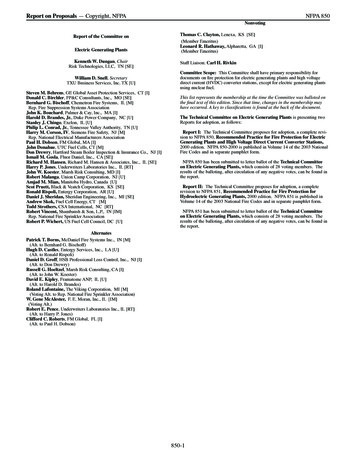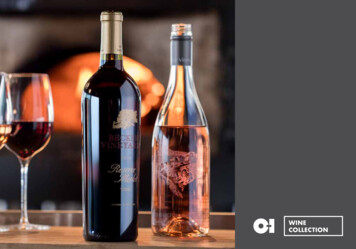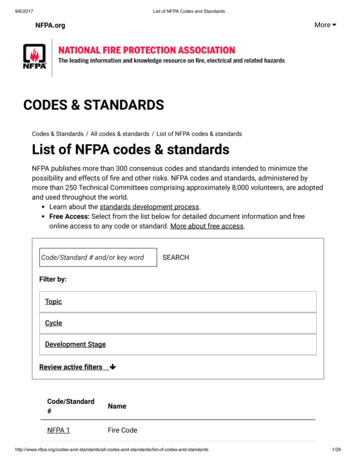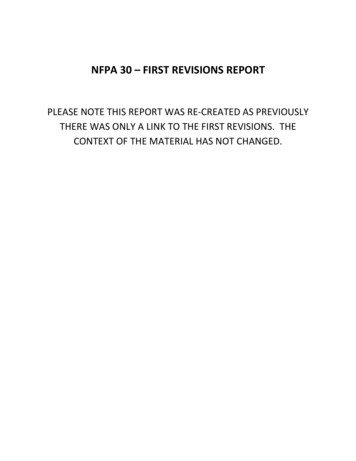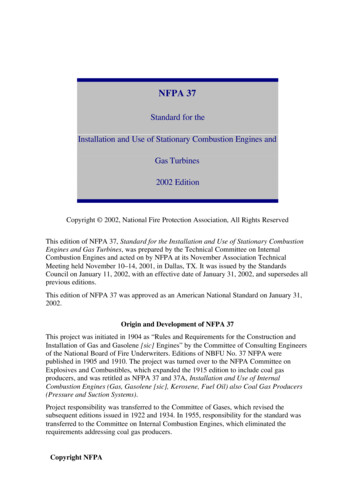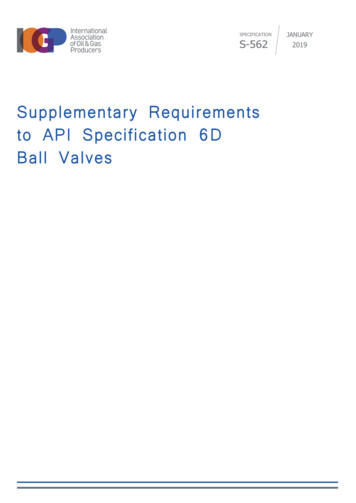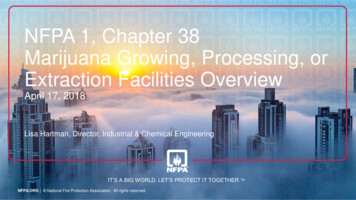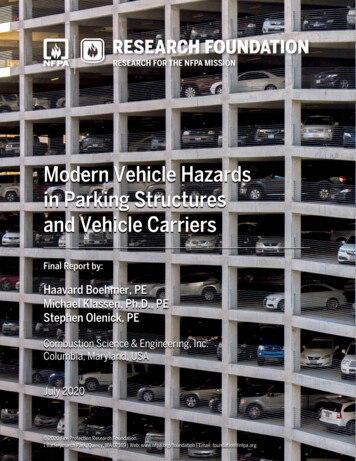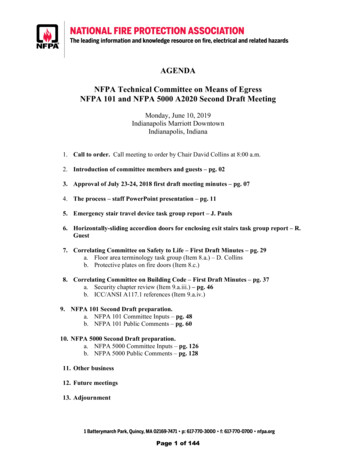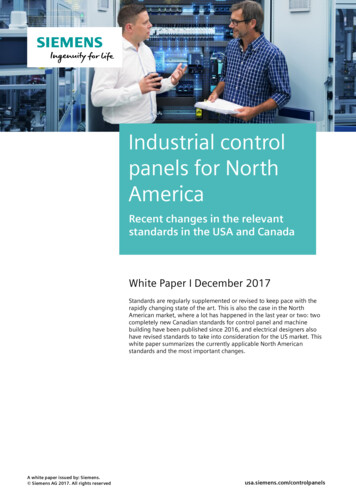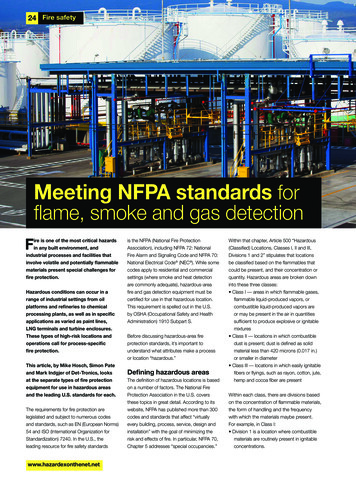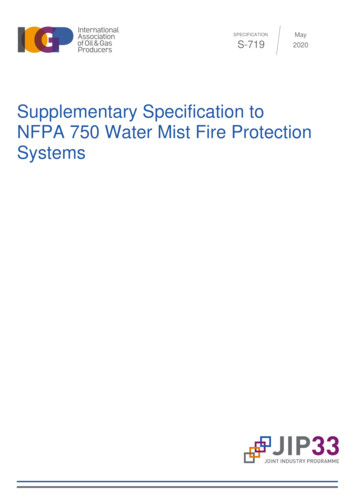
Transcription
SPECIFICATIONMayS-7192020Supplementary Specification toNFPA 750 Water Mist Fire ProtectionSystems
Revision historyVERSIONDATEPURPOSE1.0May 2020Issued for UseAcknowledgementsThis IOGP Specification was prepared by a Joint Industry Programme 33Standardization of Equipment Specifications for Procurement organizedby IOGP with support by the World Economic Forum (WEF).DisclaimerWhilst every effort has been made to ensure the accuracy of the informationcontained in this publication, neither IOGP nor any of its Members past present orfuture warrants its accuracy or will, regardless of its or their negligence, assumeliability for any foreseeable or unforeseeable use made thereof, which liability ishereby excluded. Consequently, such use is at the recipient's own risk on the basisthat any use by the recipient constitutes agreement to the terms of this disclaimer.The recipient is obliged to inform any subsequent recipient of such terms.This publication is made available for information purposes and solely for the privateuse of the user. IOGP will not directly or indirectly endorse, approve or accredit thecontent of any course, event or otherwise where this publication will be reproduced.Copyright noticeThe contents of these pages are International Association of Oil & Gas Producers.Permission is given to reproduce this report in whole or in part provided (i)that the copyright of IOGP and (ii) the sources are acknowledged. All other rights arereserved. Any other use requires the prior written permission of IOGP.These Terms and Conditions shall be governed by and construed in accordancewith the laws of England and Wales. Disputes arising here from shall be exclusivelysubject to the jurisdiction of the courts of England and Wales.
Supplementary Specification to NFPA 750 Water Mist Fire Protection SystemsForewordThis specification was prepared under Joint Industry Programme 33 (JIP33) "Standardization of EquipmentSpecifications for Procurement" organized by the International Oil & Gas Producers Association (IOGP) withthe support from the World Economic Forum (WEF). Companies from the IOGP membership participated indeveloping this specification to leverage and improve industry level standardization globally in the oil and gassector. The work has developed a minimized set of supplementary requirements for procurement, with lifecycle cost in mind, resulting in a common and jointly agreed specification, building on recognized industry andinternational standards.Recent trends in oil and gas projects have demonstrated substantial budget and schedule overruns. The Oiland Gas Community within the World Economic Forum (WEF) has implemented a Capital Project Complexity(CPC) initiative which seeks to drive a structural reduction in upstream project costs with a focus on industrywide, non-competitive collaboration and standardization. The CPC vision is to standardize specifications forglobal procurement for equipment and packages. JIP33 provides the oil and gas sector with the opportunity tomove from internally to externally focused standardization initiatives and provide step change benefits in thesector's capital projects performance.This specification has been developed in consultation with a broad user and supplier base to realize benefitsfrom standardization and achieve significant project and schedule cost reductions.The JIP33 work groups performed their activities in accordance with IOGP's Competition Law Guidelines(November 2014).Page 1 of 22S-719May 2020
Supplementary Specification to NFPA 750 Water Mist Fire Protection SystemsTable of ContentsForeword . 1Introduction . 42Referenced Publications . 63Definitions . 63.35Classification of Occupancies . 65.2912General Definitions . 6Classification of Specific Applications for Water Mist Systems . 6Design Objectives and Fire Test Protocol . 79.1General . 79.2Listing Evaluations . 7Water Supplies and Atomizing Media . 712.5 Water Supplies . 712.8 Cylinder System Redundancy . 713Plans and Documentation . 813.4 Detection, Actuation, and Control Systems Documentation . 816Marine Systems . 816.2 Sprinkler Equivalent Systems . 817Water Mist Systems for the Oil and Gas Sector . 817.1 General . 817.2 Fire Scenario .1417.3 Sprinkler Equivalent Systems / Occupancy Protection Systems .1617.4 Flammable Liquids and Gases.1617.5 Water Supply .1717.6 Power Supplies .1717.7 Location of Pressure Source Components .1817.8 Location and Environment .1917.9 Hazardous Area .1917.10 Materials .2017.11 Painting and Coating .2017.12 Low Voltage Motors .2017.13 Tubing and Fittings .2017.14 Instrumentation.2017.15 Impact of Frame Agreement .2017.16 Human Factors .2017.17 Nameplate, Tagging and Identification .2117.18 Documentation .2117.19 Inspection, Testing and Certification .21Page 2 of 22S-719May 2020
Supplementary Specification to NFPA 750 Water Mist Fire Protection SystemsAnnex AExplanatory Material .22List of TablesTable 17.1.4.1 - Efficacy and Reliability .11Page 3 of 22S-719May 2020
Supplementary Specification to NFPA 750 Water Mist Fire Protection SystemsIntroductionThe purpose of this specification is to define a minimum common set of requirements for the procurement ofwater mist fire protection systems in accordance with NFPA 750: 2019 Standard on Water Mist Fire ProtectionSystems for application in the petroleum and natural gas industries.This specification follows a common document structure comprising the four documents as shown below,which together with the purchase order define the overall technical specification for procurement.JIP33 Specification for Procurement DocumentsSupplementary Technical SpecificationThis specification is to be applied in conjunction with the supporting data sheet, quality requirementsspecification (QRS) and information requirements specification (IRS) as follows.IOGP S-719:Supplementary Specification to Supplementary Specification to NFPA 750Water Mist Fire Protection SystemsThis specification defines the technical requirements for the supply of the equipment and is written asan overlay to NFPA 750, following the NFPA 750 clause structure. Clauses from NFPA 750 notamended by this specification apply as written to the extent applicable to the scope of supply.Modifications to NFPA 750 defined in this specification are identified as Add (add to clause or add newclause), Replace (part of or entire clause) or Delete.IOGP S-719D:Data Sheet for Water Mist Fire Protection SystemsThe data sheet defines application specific requirements, attributes and options specified by thepurchaser for the supply of equipment to the technical specification. The data sheet may also includefields for supplier provided information attributes subject to purchaser’s technical evaluation. Additionalpurchaser supplied documents may also be incorporated or referenced in the data sheet to define scopeand technical requirements for enquiry and purchase of the equipment.Page 4 of 22S-719May 2020
Supplementary Specification to NFPA 750 Water Mist Fire Protection SystemsIOGP S-719Q:Quality Requirements for Water Mist Fire Protection SystemsThe QRS defines quality management system requirements and the proposed extent of purchaserconformity assessment activities for the scope of supply. Purchaser conformity assessment activitiesare defined through the selection of one of four generic conformity assessment system (CAS) levels onthe basis of evaluation of the associated service and supply chain risks. The applicable CAS level isspecified by the purchaser in the data sheet or in the purchase order.IOGP S-719L:Information Requirements for Water Mist Fire Protection SystemsThe IRS defines the information requirements, including contents, format, timing and purpose to beprovided by the supplier. It may also define specific conditions which invoke information requirements.The terminology used within this specification and the supporting data sheet, QRS and IRS follows that ofNFPA 750 and is in accordance with ISO/IEC Directives, Part 2 as appropriate.The data sheet and IRS are published as editable documents for the purchaser to specify application specificrequirements. The supplementary specification and QRS are fixed documents.The order of precedence (highest authority listed first) of the documents shall be:a)regulatory requirements;b)contract documentation (e.g. purchase order);c)purchaser defined requirements (data sheet, QRS, IRS);d)this specification;e)NFPA 750.Page 5 of 22S-719May 2020
Supplementary Specification to NFPA 750 Water Mist Fire Protection Systems2Referenced PublicationsCEN prEN 14972, Fixed firefighting systems - Watermist systems - Design and installationISO/IEC 17025, General requirements for the competence of testing and calibration laboratoriesIOGP S-718, Supplementary Specification for Field Instruments - Electronic Transmitters (Pressure,Differential Pressure and Temperature)Add to E.1.2.7FM Global Property Loss Prevention Data Sheets 2-81, Loss Prevention Data Sheet Number 2-81, FireProtection System Inspection, Testing and Maintenance, April 2019Add to E.1.2.9IMO MSC.1/Circ.1237, Amendments to the revised guidelines for the approval of equivalent water-based fireextinguishing systems for machinery spaces and cargo pump-rooms (MSC/Circ.1165)Add to E.1.2.9IMO MSC.1/Circ.1269, Amendments to the revised guidelines for the approval of equivalent water-based fireextinguishing systems for machinery spaces and cargo pump rooms (MSC/Circ. 1165)Add to E.1.2.9IMO MSC.1/Circ.1386, Amendments to the revised guidelines for the approval of equivalent water-based fireextinguishing systems for machinery spaces and cargo pump-rooms (MSC/Circ.1165)Add to sectionBS 8489, Fixed Fire Protection systems – Industrial and commercial water mist systems Part 1: Code ofpractice for design and installation33.3DefinitionsGeneral Definitions3.3.26.4Local-Application Water Mist SystemAdd noteNote: Local application systems as defined by marine requirements (IMO1387) are first response systems toprovide time for the main system (total volume protection) discharge.55.2Classification of OccupanciesClassification of Specific Applications for Water Mist Systems5.2.2Add new list item (9)(9) Oil and gas applications where fire test protocols do not currently exist (see Chapter 17).Page 6 of 22S-719May 2020
Supplementary Specification to NFPA 750 Water Mist Fire Protection Systems9Design Objectives and Fire Test Protocol9.1GeneralAdd new section9.1.5Fire Scenario Engineered SolutionsFor systems that do not comply with 9.1.1 and where a listing does not exist, a fire scenario engineered solutionshall be developed in accordance with Chapter 17.9.2Listing Evaluations9.2.6Design and Installation ManualAdd to section9.2.6.3For fire scenario engineered water mist systems, the design and installation manual shall identify the workinglimits and parameters of the system, the fire hazards, and the range of compartment variables.12Water Supplies and Atomizing Media12.5Water Supplies12.5.1Water Quality12.5.1.1.1Add to sectionThe water mist supplier shall be consulted on the use of natural seawater within the system, with clearinstructions provided in the manufacturer’s DIOM manual.Note: The use of natural seawater is for the event of the potable water not being available (e.g. depletion orproblem with supply).12.5.1.2Add noteNote: In areas where the U.S. Environmental Protection Agency do not have authority, the local or internationalrequirements, where different from 12.5.1.2, will be permitted subject to acceptance by the authority havingjurisdiction.Add new section12.8Cylinder System RedundancyCylinder redundancy requirements shall be at the acceptance of the authority having jurisdiction and/orbusiness/risk analysis.Page 7 of 22S-719May 2020
Supplementary Specification to NFPA 750 Water Mist Fire Protection Systems13Plans and Documentation13.4Detection, Actuation, and Control Systems DocumentationAdd to section13.4.7Technical File / Technical ManualFor fire scenario engineered solutions, the technical file / technical manual shall give evidence that the systemhas been designed and tested in accordance with internationally recognized standards and protocols pertinentto the risk identified and equipment to be protected by the water mist fire protection system.Note: The contents of the technical file / technical manual are clarified in IOGP S-719L.16Marine Systems16.2Sprinkler Equivalent Systems16.2.2Replace "Safety of Life at Sea (SOLAS) Regulation II-2/12.4.1" withSafety of Life at Sea (SOLAS) Regulation II-2/10.4.1Add new chapter heading17Water Mist Systems for the Oil and Gas SectorAdd new section heading17.1General17.1.1ScopeAdd new section17.1.1.1This specification is an overlay that shall be used in conjunction with NFPA 750:2019, the worldwiderecognized standard on water mist fire protection systems. Chapter 17 outlines additions to NFPA 750 forwater mist fire protection systems for onshore, offshore and marine applications within the oil and gas industry.Add new section17.1.1.2Water mist systems and their primary components shall be:(1) listed/approved; or(2) part of a fire scenario engineered system compliant with 17.2 and accepted by the authority havingjurisdiction.Page 8 of 22S-719May 2020
Supplementary Specification to NFPA 750 Water Mist Fire Protection SystemsAdd new section17.1.2PurposeThis specification shall assist the purchaser to make informed decisions on the procurement of a proven androbust water mist fire protection system.Add new section17.1.2.1The water mist fire protection system shall meet the design intent to mitigate the fire risk and specify theminimum requirements set by:(1) recognized third-party approval bodies (FM5560, Classification Society recognized type approvals orequivalent listing); or(2) defined processes for the fire scenario engineered solution.Add new section17.1.2.2The data sheet (IOGP S-719D) shall be used for clarification and project specific requirements above theminimum.Note: Deviation from this specification could result in additional cost to the product.Add new section17.1.2.3The system and its components shall be proven and qualified so that there is no need for any further or specialintervention from the oil and gas sector.Add new section17.1.3Water Mist for the Oil and Gas Industry DefinitionsThe following definitions shall be applicable to the oil and gas sector.Add new section17.1.3.1Fire Scenario Engineered SystemsFire scenario engineered water mist systems are innovative, and shall be used where international fire testprotocols and listings do not exist.17.1.3.1.1Fire scenario engineered systems shall have evidence of:(1) a fire engineered solution for the application;(2) component evaluations in accordance with 17.2.3;Page 9 of 22S-719May 2020
Supplementary Specification to NFPA 750 Water Mist Fire Protection Systems(3) an accompanying report describing pre-defined pass/fail criteria and the results of the performance-basedfire testing;(4) the manufacturer's DIOM manual.17.1.3.1.2A fire engineered solution for the application shall:(1) use existing results and knowledge to develop an acceptable solution that provides fire protectionpertinent to the risk; or(2) prove by fire testing that the solution is pertinent to the risk and carried out by an internationally recognizedand accredited fire testing laboratory.Add new section17.1.3.2Fire Scenario Engineered Test ProtocolsFire testing shall be pertinent to the risk and based on the pre-defined pass/fail criteria of the test protocol. Thefire testing shall be conducted by an ISO/IEC 17025 accredited laboratory in the presence of third-partyauthorities. The fire testing shall also be developed in accordance with prEN 14972-1:2019 (E) Annex A.Add new section17.1.3.3Primary ComponentsThe following primary components shall be tested during the manufacturing process of the water mist fireprotection system prior to factory acceptance testing (FAT):(1) nozzles;(2) flexible hoses;(3) pressurized storage containers;(4) manifolds;(5) pumps;(6) section control valves.Add new section17.1.3.3.1Components subject to pressure, for example tube, fittings, valves and pressure relief valves (PRV), shall betested during system commissioning.Page 10 of 22S-719May 2020
Supplementary Specification to NFPA 750 Water Mist Fire Protection SystemsAdd new section heading17.1.4Efficacy and ReliabilityAdd new section17.1.4.1Component ManufacturingEfficacy and reliability shall be in accordance with Table 17.1.4.1.Table 17.1.4.1 - Efficacy and ReliabilitySystem typeCompliant withMarine/offshore systems utilizing listed systems16.1.2.1, 16.1.2.2Onshore systems utilizing listed systemscomponent testing requirement of the internationallyrecognized listing organizationFire scenario engineered solutions for marine/offshore and17.2onshore applicationsAdd new section17.1.4.2Primary System ComponentsFor fire scenario engineered solutions, the primary water mist system components shall be:(1) listed/approved; or(2) traceable to listed components; or(3) at the acceptance of the authority having jurisdiction.Add new section17.1.4.3Technical FileThe manufacturer shall compile the following in a technical file:(1) engineered components that are not listed, such as nozzles; and(2) engineered components that are derived from a family or a series of components, and that are listed.Note: This will provide evidence of traceability back to the identified components.Add new section17.1.4.4Quality ManagementQuality management arrangements shall be established for the supply of the water mist system to thisspecification, conforming to the listing requirements, for the production of the following items:(1) nozzles;Page 11 of 22S-719May 2020
Supplementary Specification to NFPA 750 Water Mist Fire Protection Systems(2) flexible hoses;(3) cylinders;(4) fire fighting skid/enclosure;(5) section control valves;(6) manifolds;(7) pump systems;(8) cylinder systems.Note: FAT is agreed between supplier and purchaser, considering any listed requirements.Add new section heading17.1.5Water Mist SystemsAdd new section17.1.5.1Multiple Protected Spaces/ObjectsA single water mist system covering multiple protected spaces or objects shall be permitted.Add new section17.1.5.2Protected Spaces/ObjectsThe protected spaces or objects shall be supplied via sectional control valves.Add new section heading17.1.5.3Protected Compartments IntegrityAdd new section17.1.5.3.1For protected compartments or rooms, the opening integrity shall be defined in the manufacturer’s DIOM andwater mist system approval report.Add new section17.1.5.3.2For protected compartments or rooms, the ventilation requirements shall be defined in the manufacturer’sDIOM and water mist system approval report.17.1.6Pump RedundancyAdd new section17.1.6.1Pump redundancy shall be in accordance with 16.1.6 for offshore/marine applications.Page 12 of 22S-719May 2020
Supplementary Specification to NFPA 750 Water Mist Fire Protection SystemsNote: For the system's redundant means of pumping, the capacity is to be sufficient to compensate for the lossof any single supply pump.Add new section17.1.6.2The pump redundancy shall be at the acceptance of the owner, the water mist manufacturer and the authorityhaving jurisdiction for onshore applications.Add new section17.1.6.3The pump redundancy requirements shall not apply to a water mist system providing only local applicationprotection where the system is not the primary means of fire protection.17.1.7Controls and AlarmsAdd new section17.1.7.1Pump SystemsThe pumped water mist system controls shall be at the acceptance of the AHJ, and one of the following:(1) for listed offshore/marine applications, in accordance with 16.1.7.1;(2) for fire scenario engineered solutions for offshore/marine applications, in accordance with themanufacturer's DIOM manual or fire scenario engineered test report;(3) for listed onshore applications, in accordance with the manufacture's listing;(4) for fire scenario engineered solutions for onshore applications, in accordance with the manufacturer'sDIOM manual or fire scenario engineered test report.Add new section17.1.7.2AnnunciationThe annunciation shall be at the acceptance of the AHJ, and one of the following:(1) for listed offshore/marine applications, in accordance with 16.1.7.2;(2) for fire scenario engineered solutions for offshore/marine applications, in accordance with themanufacturer's DIOM manual or fire scenario engineered test report;(3) for listed onshore applications, in accordance with the manufacture's listing;(4) for fire scenario engineered solutions for onshore applications, in accordance with the manufacturer'sDIOM manual or fire scenario engineered test report.Add new section17.1.7.3Flow Condition AlarmThe flow condition alarm shall be:Page 13 of 22S-719May 2020
Supplementary Specification to NFPA 750 Water Mist Fire Protection Systems(1) for offshore/marine applications, in accordance with 16.1.7.3; or(2) for onshore applications, in accordance with the manufacturers listing or manufacturer's DIOM manual.Add new section17.1.7.4Pressure MonitoringPressure monitoring shall be:(1) for offshore/marine applications in accordance with 16.1.7.4; or(2) for onshore applications, in accordance with the manufacturer’s listing and at the acceptance of theauthority having jurisdiction.Add new section17.1.8Pipe PenetrationsPipe penetrations shall be:(1) for offshore/marine applications, in accordance with 16.1.8;(2) for onshore applications, at the acceptance of the authority having jurisdiction.Note: Penetrations through fire rated or blast rated walls should be avoided. If they cannot be avoided, it shouldbe ensured that the design of the penetration does not compromise the original fire and blast rating of the wall.Add new section17.2Fire ScenarioAdd new section17.2.1Fire Scenario Engineered SystemsFor fire scenario engineered systems that are innovative and have not yet been addressed by water mistinternational standards, the water mist system manufacturer shall provide evidence of the following:(1) fire scenario engineered solution (17.2.2);(2) fire test protocols (17.2.3);(3) component evaluation (17.2.4);(4) fire scenario engineered test report (17.2.5);(5) fire scenario engineered test documentation (17.2.6).Add new section17.2.2Fire Scenario Engineered SolutionThe fire scenario engineered solution shall be a collaborative fire engineered solution, developed and agreedbetween the third parties, on a case by case basis, based on:Page 14 of 22S-719May 2020
Supplementary Specification to NFPA 750 Water Mist Fire Protection Systems(1) the use of existing test results and knowledge to develop an acceptable solution providing fire protectionpertinent to the risk; or(2) fire testing pertinent to the risk and carried out by internationally recognized accredited fire testinglaboratory.Add new section17.2.3Fire Test ProtocolsFire test protocols shall be developed in accordance with prEN 14972-1:2018 (E) Annex A.Add new section17.2.4Component EvaluationListed primary or engineered system components verified with the technical report shall be used.Add new section17.2.4.1The water mist manufacturer shall evaluate the non-listed primary mist systemwhere performance objectives have been met.componentsNote: Non-listed primary water mist system components fall into two categories:(1) brand new components (see 17.2.4.2);(2) components that have been modified or engineered from listed components to perform and achieve therequired results (see 17.2.4.3).Add new section17.2.4.2For new components (defined in 17.2.4.1), component testing shall be in accordance with the pass/fail criteriaof a recognized international procedure, for example:(1) FM Approvals Approval Standard for Water Mist Systems Class Number 5560;(2) IMO MSC/Circ. 1165.Note: IMO MSC/Circ. 1165 is for nozzles only.Add new section17.2.4.3Components that have been modified or engineered from listed components shall be reviewed betweeninvolved parties to establish if further component testing required.Add new section17.2.5Fire Scenario Engineered Test ReportFor fire scenario engineered solutions, the third-party fire test report shall provide:Page 15 of 22S-719May 2020
Supplementary Specification to NFPA 750 Water Mist Fire Protection Systems(1) the outcome of the performance-based fire testing certifying that the system performance met theperformance limits of the test protocol;(2) evaluation of components and system hardware;(3) applications and limitations;(4) details of drawings, documents for the primary components;(5) fire test protocols.Note: The water mist system manufacturer shall document this within a technical file to be provided within oralongside the DIOM manual.Add new section17.2.6Fire Scenario Engineered Test DocumentationFor fire scenario engineered solutions, the documentation required to accompany the water mist system shallbe in accordance with 17.18.Add new section heading17.3Sprinkler Equivalent Systems / Occupancy Protection SystemsAdd new section17.3.1Sprinkler Equivalent SystemsFor marine/offshore applications, sprinkler equivalent systems in accordance with 16.2 shall be installed whereautomatic water mist nozzles are provided, with class A combustibles being the predominant hazard, forexample in accommodation spaces, public spaces, galleys and storerooms.Add new section17.3.2Occupancy Protection SystemsFor onshore applications, occupancy protection water mist systems shall use automatic water mist nozzlesinstalled throughout a building or a por
Supplementary Specification to NFPA 750 Water Mist Fire Protection Systems Page 8 of 22 S-719 May 2020 13 Plans and Documentation 13.4 Detection, Actuation, and Control Systems Documentation Add to section 13.4.7 Technical File / Technical Manual
